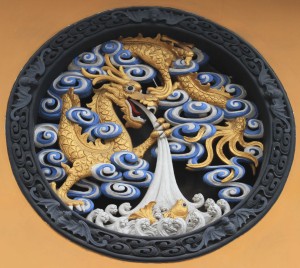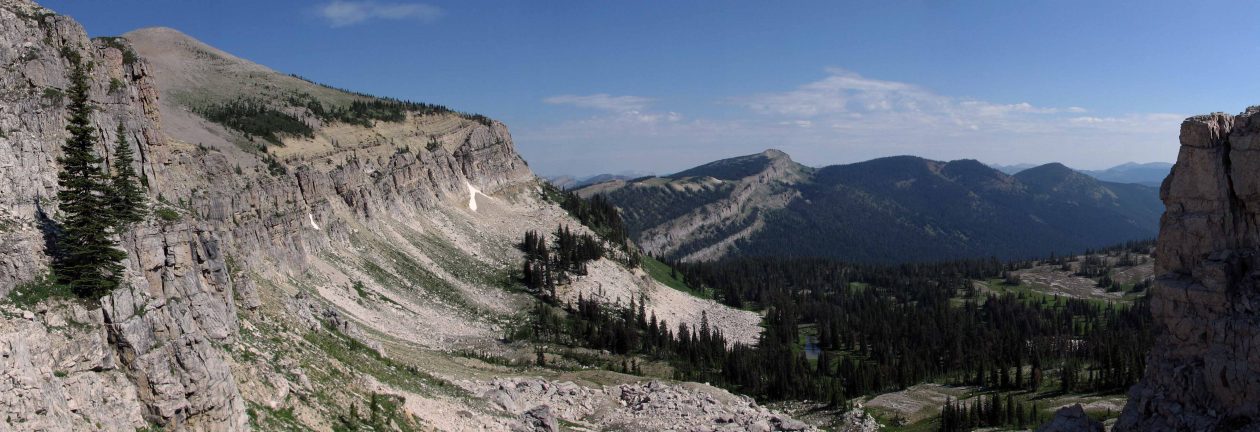Shanghai, China
Got up today in search of a place to eat breakfast and ended up at the same place I had lunch at yesterday (I had eggs, bacon, sausage, hash browns, a chocolate muffin, and a cappuccino). Immediately upon exiting the hostel, it was drizzling rain and the weather would remain unchanged for the most part until the afternoon. Soon after I had acclimated my mind to put up with the rain and ensuing wet clothes, I remembered that China is very polluted and there was a good chance this rain had a low pH. It would be prudent of me to spend as little time out in the elements as possible, lest I want to look like one of those weathered statues you see in environmental science articles. With that thought in mind, I headed toward People’s Square to see if I could find the bus to the ancient town of Zhujiajiao in hopes that it may not be raining out there, but since I had left uninformed, I did not know which bus to look for. I conceded defeat and decided to stick with my original plan of visiting the local temples today.
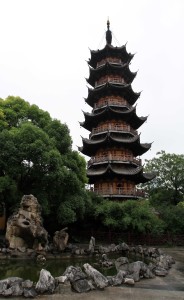
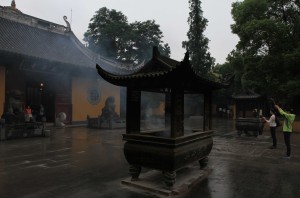
I entered the subway and reemerged above ground at Longhua Temple – a Buddhist temple. The most distinctive building at this temple is actually outside the complex; it is a tall wooden pagoda – a beautiful structure amongst the drab deteriorating buildings and construction going on nearby. I entered the complex (paying the entrance fee) and wandered around looking inside each building. In three separate rooms adjacent to each other were three different religious ceremonies. The first one had monks (dressed in off-yellow robes – all three temples I visited today in Shanghai had the monks wearing these yellow robes, not like the typical red-dominant/yellow robes you see associated with Tibet or, from what I witnessed, Mongolia and Korea) standing around the room chanting; the second one had monks chanting and banging on drums and metal instruments; the third room had the monks seated around a long table chanting (possibly before a physical or spiritual meal). I didn’t pry for too long since I didn’t want to intrude, even with only my eyes. All in all, I spent about an hour there before moving on to the next temple . . .
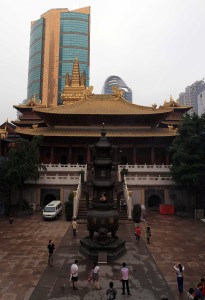
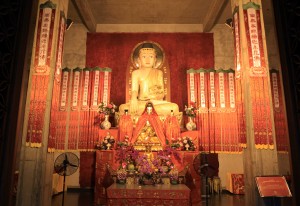
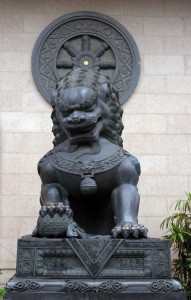
. . . Jing’an Temple, which was another Buddhist Temple. This temple was situated right outside of a Versace cologne pavilion, fashion stores, malls, and sleek skyscrapers . . . which was actually kind of fitting for this temple; for even though it had an 1,800 year history, it had been rebuilt and renovated a number of times (the left and right sides of the complex were actually being renovated when I visited), making itself look sleek, modern, and stylish (it too was a high-rise building, even with elevators installed for the monks to reach the topmost floors with ease). The most prominent feature was the center temple that had steps leading up to it; inside it had a high-vaulted ceiling made of polished logs and a giant Buddha statue was in the middle for worshipers to pray to; in fact the whole complex really out did itself with wonderful wood carvings. Too bad the left and right sides being renovated were covered in blue tarps and scaffolding, otherwise it would have proved to be an incredibly impressive sight. I then left to see the last temple on my list for today . . .
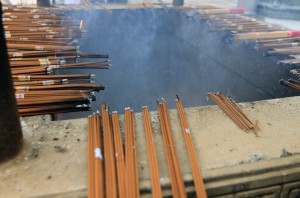
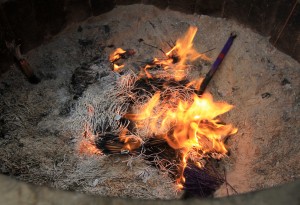
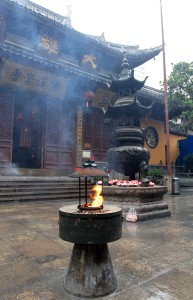
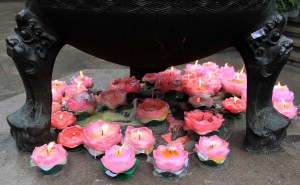
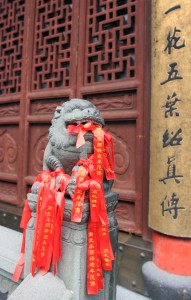
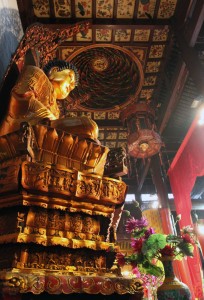
. . . the Jade Buddha Temple, which earned it’s name due to a jade Buddha statue it has in its possession. As with the other two temples, I paid the entrance fee (after finally finding the temple – it was not nearby the subway exit and the tourism map I had didn’t help much). This temple complex was similar to the Longhua Temple and other previously visited temples in China; it had the multiple buildings running along the sides with the main hall buildings running down the central axis. This temple had many sticks of incense burning just like the other two (and all the other Buddhist temples in China), but also had wax candles shaped and colored to look like lotus flowers. Inside one of the main halls were row after row of plastic-shaped lotus flowers with electric lights in them flanking the side walls. I then ventured further back inside the complex to see the famed Jade Buddha statue and, much to my surprise, I had to pay an additional fee to see the statue – of course most tourists coming here would automatically assume that the temple complex’s namesake would be included with the entrance fee, but I guess not; I suppose most worshipers don’t bother to see it again after having seen it once, so they just pay the entrance fee, pay for the incense sticks, pray, and then possibly pay for a gift at one of the many gift shops to be found throughout the temple complex.
Mon – ey, mon – ey, mon – ey, mon – ey, . . . mon – ey!
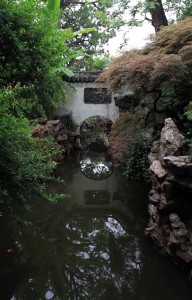
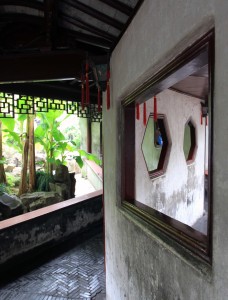
Thank you The O’Jays. After finishing looking around the three temples, I rode the subway to the Shanghai Railway Station to buy my onward ticket to Hangzhou for the 22nd. This is the second time being able to type my requested date, time, and destination for tickets on my iPhone has helped at the Railway Ticket Office since most employees in China don’t speak English and I don’t carry a pen or pad with me. I then rode the subway to the station nearest the Yuyuan Gardens, which was located in the “Shanghai Old Street” district I was in yesterday. I located the gardens, entered inside and spent a solid two hours walking around that labyrinth. The size wasn’t that big, but there were so many walls, corridors, rock passageways, streams, bridges, pavilions, halls, and ponds that one has to be really thorough to ensure they see it all. It was very beautifully made, a model of classical Chinese gardening, originally built during the reign of Ming Emperor Jiajing (in 1559 AD); although, it was more man-made structure than natural garden. Once finished, I headed back the way I came in, but the entrance had already been shut, so I had to find my way back to the other exit; if the garden had really been a labyrinth and I had entered with a group of other people and there was no one else but us and the entrance was closed and we had to find the exit but couldn’t and grew ever more and more frustrated as time progressed and spousal conflicts erupted, then the situation would’ve been perfectly suited for a Luis Buñuel film. I did locate the exit with relative ease though and was soon out in the crowds and souvenir shops again.
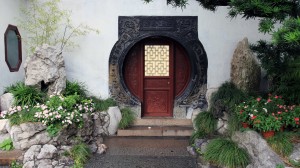
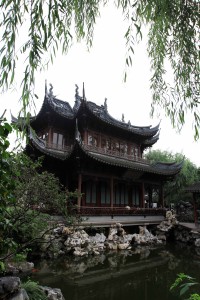
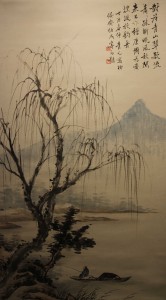
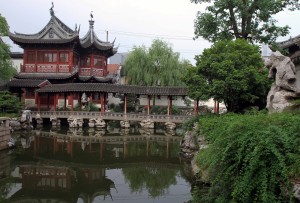
I then walked back to the riverfront and saw the skyscrapers shrouded in misty clouds. I walked north heading toward the 1933 Millfun structure, a unique architectural building designed to be a rectangle with a cylindrical building in the center of it’s courtyard and many passage ways linking the two. It was cool to see, but not much else was there and the walk wasn’t quite worth it. I then took the subway back to the hostel and went to a nearby restaurant for dinner. I was seated in the center of the first floor in full view of the pedestrians outside. I ordered my food and had “Forest starch” (some type of green stalks, mushrooms, and some carrots and onions), “Tea tree sauce braised pork” (pork, peanuts, carrots, red peppers, and a delicious oily sauce which I guess was made from “tea tree”), soy fried rice, and beer. Overall, it was very satisfying. Also, while eating, I noticed two groups of two Westerners come inside to eat; I then realized that perhaps I was placed at the center table for a reason; well played restaurant staff, glad I could be of some service. I finished my meal, headed back to the hostel, planned out tomorrow’s travels, drank some beer, and typed today’s entry before finally sleeping.
Postscript: the medicine I had bought yesterday evening is helping; I didn’t cough nearly as much today as I did during the previous ten days.
